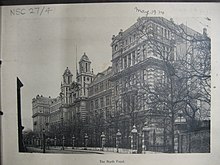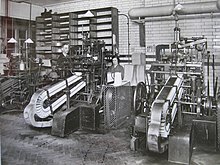Blythe House

Blythe House is a listed building located at 23 Blythe Road, West Kensington,
Post Office Savings Bank
Blythe House was built between 1899 and 1903 as the Headquarters of the Post Office Savings Bank, which had outgrown its previous offices at Queen Victoria Street. By 1902 the Bank had 12,000 branches and more than 9 million accounts, with some 4,000 headquarters staff.[2]
The complex included a post office, "intended mainly to deal with the extensive official correspondence involved in the work of the Savings Bank."[3] The post office handled a ton of post (about 100,000 letters) every working day.[4] The post office building still houses the West Kensington delivery office.
The main hall on the ground floor gave access to the offices of the Controller and his staff, and also the Public Enquiry Office. The first floor housed the correspondence branches, while the ledger branches were on the floors above. The top floor was mostly taken up with dining rooms and a kitchen.[3]
Approximately 1,000 of the staff were female; to avoid the risk of improper mixing of the sexes, females were segregated in the south block of the building, which had its own entrance.[5]
The work of the Bank increased greatly during the
By the 1930s continuing increases in the Bank's business, and the proposed move of the Savings Certificate department to Blythe House,[7] necessitated further expansion and Treasury authority for a western extension was given in 1938.[8] However, presumably because of the looming threat of war, the scheme was omitted from the Ministry of Works building programme, and planning postponed indefinitely.[9] The western extension was never built.
In 1963 the government announced that the Bank's main centre of operations would be moved to Glasgow, in line with its general policy of dispersing civil service departments out of London. A small headquarters staff remained in London, moving to Charles House on Kensington High Street.[10] The Bank finally vacated Blythe House in the early 1970s.
-
The main block of Blythe House, in c.1924
-
The eastern extension of Blythe House, with the post office in front
-
Female clerks attending to savings ledgers
-
Clerks operating adding machines c.1924
-
Machines used to fold envelopes for the Savings Bank's extensive correspondence
-
1930s clerks preparing daily balances
-
The Post Office Savings Bank logo in mosaic on the east wall of Blythe House
Proposed and temporary uses
After the Savings Bank dispersal was announced, several proposals were made for the Blythe House site.
It was rumoured that the restaurant chain J. Lyons and Co., whose food preparation factory Cadby Hall was adjacent to Blythe House, wanted to acquire the site.[12]
Hammersmith Chess Club used Blythe House as their home venue for a period of time in the mid 70s, having moved on from a draughty and cold St Paul's Church Hall nearby.[13]
In the summer of 1979 Blythe House was used for the temporary exhibition of gifts to the Queen from the All-Japan Handicraft Cultural Association, given in connection with the Silver Jubilee celebrations.[14]
Museum stores

In 1979 Blythe House was formally acquired by the Government from the Savings Bank for £6.5m,
The building is now used to store small and medium-sized artefacts from the collections of three museums:
- The British Museum from previous stores at Crayford, Kent; Shepherdess Walk; and Edgware Road.[18]
- The Science Museum, including items from the Wellcome Trust collections; a conservation laboratory, a photographic studio, and a quarantine area where newly arrived items are examined.[19]
- The The National Archives; and Hounslow), including the Archive of Art and Design; the Beatrix Potter Collections; the V&A Theatre and Performance Archives; and the V&A's own institutional archive.[20]
In 2015 the government announced it was selling the building and asked the museums to find a new home for their collections. [21] The Science Museum will vacate the building in 2024 having moved 300,000 objects to Wroughton near Swindon. [22]
Architecture
Blythe House was designed by the
The walls of the main workrooms were clad in glazed bricks, rather than the usual plaster. These were said to "afford a good reflecting surface for light and are also to be commended for sanitary reasons."
Blythe House and the associated post office were listed grade II in 2004.[2][4]
Film location
Blythe House was used as a location for television series in the late 1970s and early 1980s, including Minder and The New Avengers. The building is featured extensively as the fictional headquarters of "The Circus" in the 2011 film Tinker Tailor Soldier Spy.[26] Used as exterior shots of ITV drama The Halcyon and the Netflix series The Crown.
Used to portray a hospital in the film The Father.
Notable people
- Michael Collins was employed as a boy clerk at Blythe House from July 1906 – April 1910.[27][28][29]
References
- ^ "Spending review and autumn statement 2015". GOV.UK. Retrieved 24 August 2023.
- ^ a b c Historic England. "Details from listed building database (1390961)". National Heritage List for England. Retrieved 21 September 2011.
- ^ The National Archives: Public Record Office NSC 23/4 Planning of the Blythe Road building.Unsigned memo. Undated but likely 1899–1908
- ^ a b Historic England. "Details from listed building database (1390960)". National Heritage List for England. Retrieved 8 October 2011.
- The National Archives: Public Record Office NSC 23/4 Planning of the Blythe Road building.Unsigned memo. c.1900
- The National Archives: Public Record Office NSC 23/6 Erection of extension to the Blythe Road building (East Block)Memo signed "AGF" reference 224666/18. 2 June 1919
- The National Archives: Public Record Office NSC 23/13 Proposed extension to West Side of Blythe Road buildingMinutes of Post Office Savings Coordination Committee. 23 September 1935
- The National Archives: Public Record Office NSC 23/13 Proposed extension to West Side of Blythe Road buildingStanding Committee for Buildings Expenditure "Buildings Programme 1938–39". Paper B.897
- The National Archives: Public Record Office NSC 23/14 Proposed extension to West Side of Blythe Road buildingMemo 67156/38. 3 March 1939
- The National Archives: Public Record Office WORK 12/716 National Savings Bank, Blythe Road, Kensington: future use of siteJL Winterburn (GPO) to MM Howley (Ministry of Public Buildings and Works). 29 August 1963
- The National Archives: Public Record Office WORK 12/716 National Savings Bank, Blythe Road, Kensington: future use of site HT Woolcott (valuer to London County Council) to Postmaster Generalref VA/A/N/HM/58678. 29 July 1963
- ^ The National Archives: Public Record Office WORK 12/716 National Savings Bank, Blythe Road, Kensington: future use of siteG Challis (Assistant Secretary, Civil Service Clerical Association) to PD Jones (Civil Service National Whitley Council). 29 April 1969
- ^ "A Brief History of Hammersmith Chess Club – Hammersmith Chess Club". Hammersmith Chess Club.
- The National Archives: Public Record Office WORK 17/529 Blythe Road, Kensington: storage for museumsLG Dickson (Assistant Director, The Royal Jubilee Trusts) to RG Clubley (Department of the Environment) ref GEN/J/2. 27 July 1979
- The National Archives: Public Record Office WORK 17/528 Blythe Road, Kensington: storage for museumsBE Hodgson (Property Services Agency) to BD Ponsford (FHG). 16 March 1979
- ^ The National Archives: Public Record Office WORK 17/528 Blythe Road, Kensington: storage for museumsSJ Battershall to JM Warnes & GAE Gray, ref ESS/A/[illegible]. 21 June 1978
- The National Archives: Public Record Office WORK 17/528 Blythe Road, Kensington: storage for museumsSir Roy Strong to Lady Birk (Minister of State, Department of Environment), handwritten postscript. 20 November 1978
- ^ "British Museum Act 1963 (Third Schedule: Sites of Authorised Repositories, as amended)". Her Majesty's Stationery Office. Retrieved 21 September 2011.
- Science Museum (London). Archivedfrom the original on 2 February 2010. Retrieved 21 September 2011.
- ^ "Archives – Victoria and Albert Museum". Victoria and Albert Museum. 17 September 2011. Retrieved 21 September 2011.
- ^ "Science Museum in 'world's biggest house move' to Swindon". BBC. 18 June 2021. Retrieved 26 November 2023.
- ^ "Museum's move to Wiltshire like 'game of battleships'". BBC. 24 November 2023. Retrieved 26 November 2023.
- ^ "Closure of Savings Bank Electric Plant Power Station; agreement for the supply of electricity by the Hammersmith Borough Council (NSC 23/7)". National Archives/Post Office Savings Bank and Post Office Savings Department. 1919–1925. Retrieved 21 September 2011.
- ISBN 0-300-09652-6.
- The National Archives: Public Record Office WORK 12/108/5 Savings Bank, Blythe Road, West Kensington. Purchase of site and erection of building. Laying of foundation stone by H.R.H. the Prince of WalesController of Savings Bank to Secretary, Ministry of Works. 23 March 1899
- ^ "Film London – September 2011 – Blythe House". Film London. Archived from the original on 2 April 2012. Retrieved 21 September 2011.
- ISBN 0099685809.
- ISBN 1851588574.
- ISBN 1405090200.







